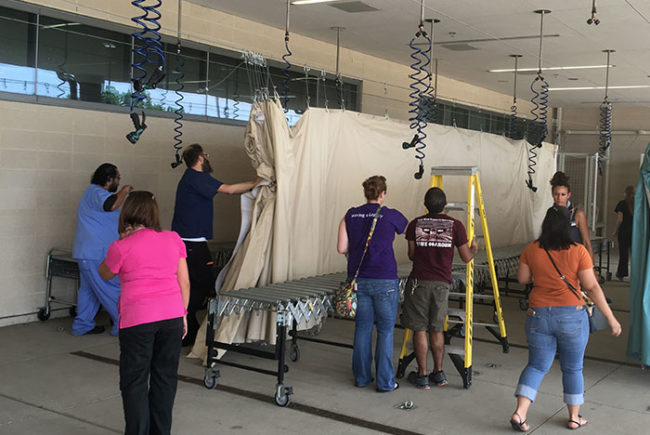Being prepared for chemical or biological emergencies means having the right supplies at the right time. Having established partnerships with key suppliers literally can be a lifesaver during unforeseen events. Greg May, CHESP, system director of environmental services and linen service at Swedish Medical Centers in Seattle, says that when establishing agreements, hospitals should include suppliers outside of their local areas or suppliers with national resources.
“In the case of a catastrophic event in one area, local supplies may disappear quickly, so your suppliers need the ability to pull from other areas of the region or country,” May says. “Don’t forget to contract with a company to handle waste created by decontamination. Once you decontaminate patients exposed to hazardous materials, you have water that must be disposed of properly. Hospitals are responsible for the waste recovered, so you must make sure the containment, removal, transport and disposal are handled according to Environmental Protection Agency guidelines.”
However, even if a third-party provider is handling the actual disposal process, the hospital environmental services staff must have the equipment on hand to contain the water and be able to move it to a collection area for pickup. “You will have 55-gallon barrels of water to move so employees will need carts or other equipment to enable movement,” says May.
Out of 500 environmental services employees, May trains about 50 people to handle emergencies and schedule them so that a team that has undergone proper training and practiced techniques through drills is on duty for all three shifts, seven days a week. “It’s not practical to train the full staff, but focusing on a smaller emergency response team with the knowledge to handle situations is important,” he explains.
Finally, remember that purchasing emergency supplies is not a one-and-done event. “Be sure to perform a routine inspection and inventory of all emergency supplies,” May says. “My department serves as the spill response team, so we do have a variety of absorbents for different types of spills."
Enforce with members of the environmental services team the importance of tracking supplies, so the department has an accurate picture of its needs. Employees don’t always document use of a small amount, but it adds up to big numbers over time.
“The same thing happens with HEPA filters for our vacuums — they are ‘borrowed’ and not returned to their original location and filters are used,” May explains. “The only way to make sure you are prepared is to be sure your inventory is accurate.”
Sheryl S. Jackson is an Atlanta-based freelance writer who covers management, leadership and business trends for the health care, construction, supply chain and facilities management industries.
AHE INSIGHTS
Practice guidance available
Practice Guidance for Healthcare Environmental Cleaning, second edition, helps to define and advance the professionals responsible for care of the health care environment to ensure high-quality outcomes and healthy communities.
This manual provides evidence-based research, guidance and recommended practices that should be considered for inclusion in health care environmental services departments. Because each facility has its own needs, this resource has been designed to enhance an existing program.
Click here for more information.
Certified Healthcare Environmental Services Technician Certificate
This certification focuses on critical areas of competency for front-line technicians, including infection prevention, quality of care, patient outcomes and experience.
Click here for more information.
Environmental Sustainability Certificate Program
AHE has launched a certification to acknowledge the environmental and ecological sustainability efforts of environmental services departments.
Click here for more information.





